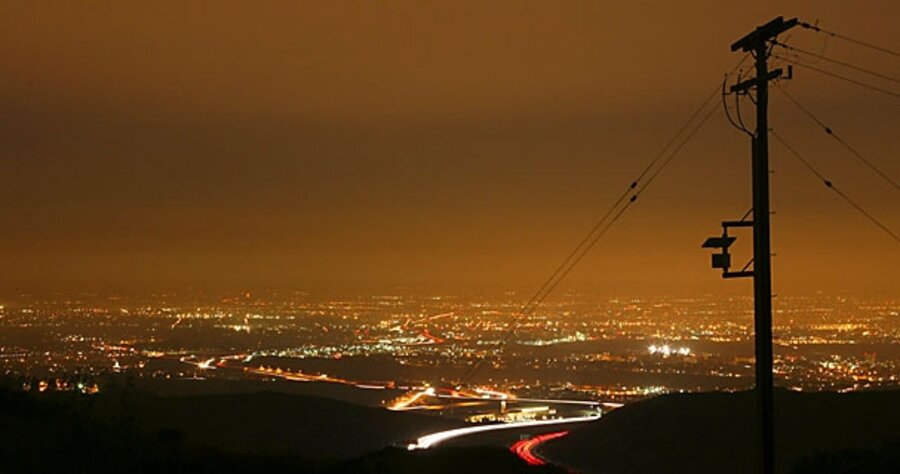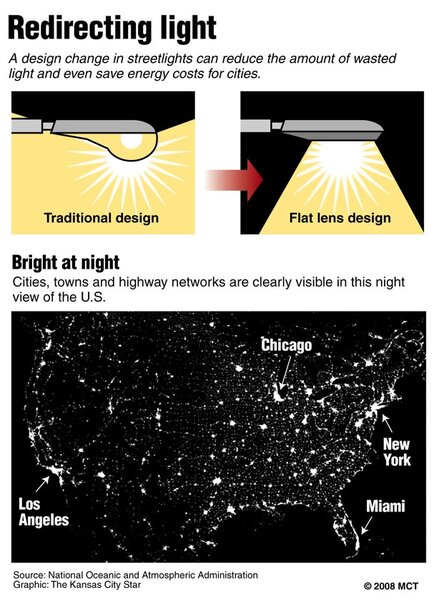Light pollution harms not just stargazers
Loading...
For students of astronomy, Sunday and Monday night is the equivalent of a World Cup Final, a new Mac operating system, and a Zeppelin reunion show all rolled into one.
That's because, as Horizons guest blogger Pete Spotts noted in his post Sunday, Jupiter, Venus, and the moon will gather to direct a lopsided frown at North America, an arrangement that won't happen again for another 44 years.
But even on a clear night, many would-be astronomers are missing out on this rare celestial scowl, instead being treated to a dull haze punctuated by only the nearest or brightest objects, Jupiter not being one of them. So pervasive is this murky veil that the National Park Service estimates that two-thirds of Americans cannot see the Milky Way from their homes. Had Carl Sagan spent his whole life in a contemporary US city, he'd no doubt have marveled at the dozens and dozens of lights dotting the firmament.
The cause of this stellar pall? Carelessly designed streetlamp fixtures, signs, and office lighting controls that pointlessly illuminate the sky, blocking our view of the universe.
Harmful to wildlife, harmful to humans
But stymied stargazers may be the least of our worries. Light pollution also wreaks havoc on ecosystems. Migratory birds, accustomed to navigating by the stars, smack into brightly lit office buildings. Others endlessly circle spotlights and gas flares until they drop dead by the thousands. Owls lose the element of surprise over their prey. Rodents forage more cautiously. Insects are drawn to their deaths. Frog orchestras miss their cues. Mating schedules get thrown off. Migrations start late, consigning itinerant creatures to starvation.
And then there's the baby sea turtles. For almost the entire history of the species, the brightest object in the night sky was the moon, which hatchlings would use to guide them to the ocean. But with the rise in poorly designed artificial lighting, the young reptiles are now likely to strike out toward the minimart across the highway from the beach.
It's not just animals who are being flummoxed by our efforts to create a permanent daylight. As this month's National Geographic points out, we're making an end-run around our own circadian rhythms. Verlyn Klinkenborg writes:
For the past century or so, we've been performing an open-ended experiment on ourselves, extending the day, shortening the night, and short-circuiting the human body's sensitive response to light. The consequences of our bright new world are more readily perceptible in less adaptable creatures living in the peripheral glow of our prosperity. But for humans, too, light pollution may take a biological toll.
Not even safe
It would be one thing if all this light contributed to public safety, that is, if the illumination actually reduced the chances of a nighttime collision or mugging. But many of our light fixtures cast light sideways and upwards, temporarily blinding us and creating dark spots that we could otherwise see into. As the New Yorker's David Owen wrote last year, our light fixtures tend to create "glare bombs" that obscure as much as they illuminate.
Much so-called security lighting is designed with little thought for how eyes—or criminals—operate. Marcus Felson, a professor at the School of Criminal Justice at Rutgers University, has concluded that lighting is effective in preventing crime mainly if it enables people to notice criminal activity as it’s taking place, and if it doesn’t help criminals to see what they’re doing. Bright, unshielded floodlights—one of the most common types of outdoor security lighting in the country—often fail on both counts, as do all-night lights installed on isolated structures or on parts of buildings that can’t be observed by passersby (such as back doors). A burglar who is forced to use a flashlight, or whose movement triggers a security light controlled by an infrared motion sensor, is much more likely to be spotted than one whose presence is masked by the blinding glare of a poorly placed metal halide “wall pack.” In the early seventies, the public-school system in San Antonio, Texas, began leaving many of its school buildings, parking lots, and other property dark at night and found that the no-lights policy not only reduced energy costs but also dramatically cut vandalism.
An easy fix
Fortunately, of all types of pollution, light pollution is probably the easiest to fix. In most cases, it's simply a matter of aiming low.
The International Dark-Sky Association, a collection of astronomers, environmentalists, and others devoted to combating destructive outdoor lighting, has developed a certification program for fixtures that enhance visibility while directing light only where it is needed, that is, at the ground.
An example of this is a streetlamp whose bulb is flush with the hood, so that light is directed only below the horizontal. Other fixes include installing timed or motion-sensitive residential lights, improving light controls in office buildings so that they use light only where it is needed, and avoiding over-illumination.
As a bonus, many of these steps also save energy. According to the US Energy Information Administration, Americans spend about a quarter of their electricity on lighting, at an annual cost of more than $37 billion.
And let's not discount the joy of looking up and seeing, instead of a drab void, a boundless expanse of stars. Such a spectacle, which for too many Americans is relegated to a once-a-year camping trip, could help all of us appreciate the scale of the universe and our place in it. It might just remind us of the improbability and precariousness of our existence here on earth, and might even inspire us to work a little harder to preserve it.







